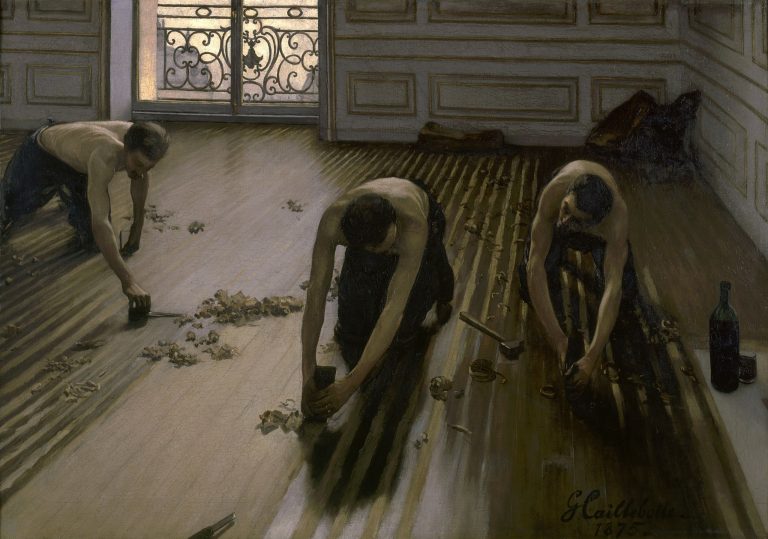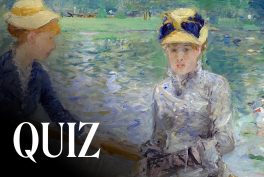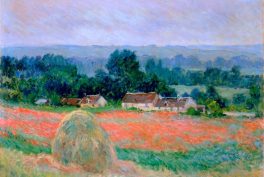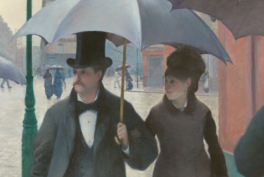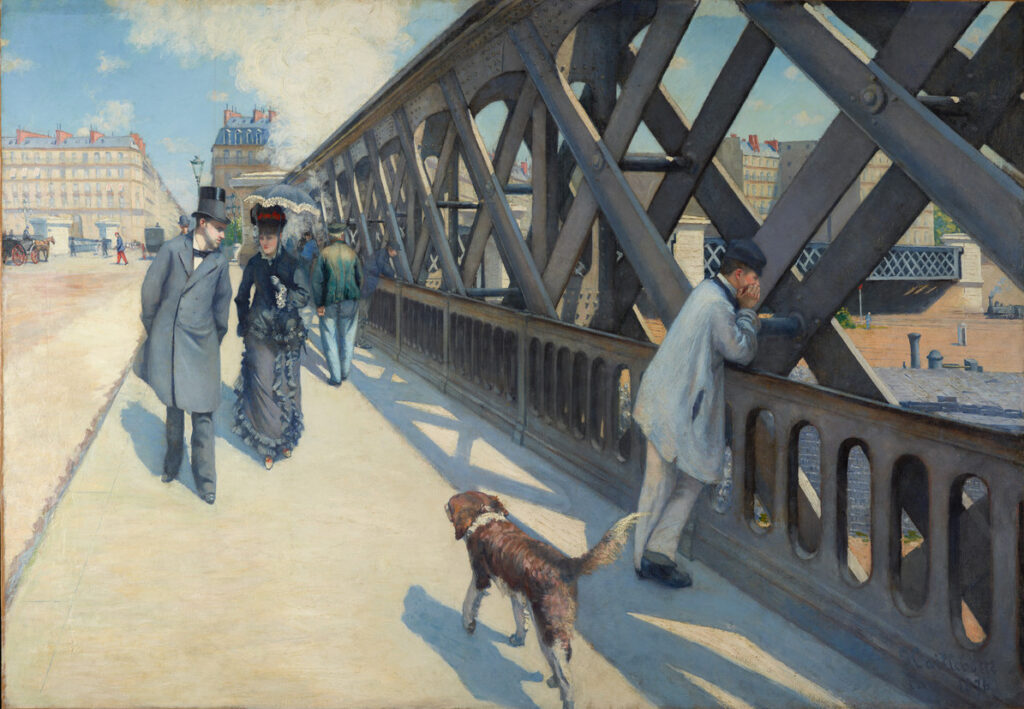1. An Impressionist Also-Ran
For many years, Gustave Caillebotte (1848–1894) was dismissed as a minor Impressionist, a younger artist who admired and tried to emulate, or imitate, the works of his idols, Claude Monet and Edgar Degas. It is true that Caillebotte often depicted similar subject matter. Argenteuil, a village on the Seine, was a popular leisure destination for Parisians who could get there easily by train, as well as an industrial location—you can see distant factory chimneys in many of the works. It was painted by Pierre-Auguste Renoir, Camille Pissarro, and Monet, who had a house there.
Caillebotte’s The Seine at Argenteuil uses choppy impressionistic brushwork and a characteristic flattened perspective with the angles of the grass in the foreground set off against a wall of water behind. At first sight, it does seem derivative. But it was painted in 1892, almost twenty years after Monet and Renoir had worked at Argenteuil, at a time when the solidarity of the Impressionist group was a distant memory. This is a nostalgic picture. Caillebotte is not copying, he is looking back fondly.
2. Painter and Collector
Gustave Caillebotte did not set out to be an artist. He came from a wealthy background—money which he would later use to create a large collection of Impressionist works. He trained as a lawyer. Like many young men in France, his life was thrown off track by the 1870 Franco-Prussian War. It was after serving in the military when he decided to become a painter.
This self-portrait shows him at his easel, paint brushes in hand and surrounded by canvases. However, if you look at the painting in the background it is recognizably Renoir’s Dance at the Moulin de la Galette. Caillebotte is showing himself to be a collector as well as a painter. He used his considerable wealth to buy Impressionist works, and at the age of only 28 wrote a will leaving his collection to the French state. He also put money, as well as time and effort, into the Impressionist exhibitions—arguably the third group show in 1877 would not have happened without Caillebotte’s diplomacy.
The most striking aspect of the self-portrait, however, is the representation of space. Caillebotte does not show the floor and squashes the distance between himself, large in the foreground, and the figure reading behind. Unusual perspective was one of his key interests.
3. Looking at Life
Like many artists, Caillebotte tried to get his work accepted at the official Salon. When that failed, he exhibited six paintings at the Second Impressionist Exhibition in 1876, including Young Man at His Window. This picture, of his own brother, in the family home in Paris, establishes many of the key themes of Caillebotte’s work. It focuses on a comfortable middle-class existence in the well-to-do boulevards of Haussmann’s newly designed city. It takes a traditional idea—the rückenfigur (back view) which had been popularized by Caspar David Friedrich—and makes it fresh, by angling the picture space, and juxtaposing a claustrophobic, dark interior with an airy lightness beyond.
The viewer is put in the position of a visitor in the Caillebotte home, perhaps even trying to converse with the young man, but he seems distracted by the view outside, the view we can only partially see. The man’s pose is casually proprietorial, with his wide stance and hands in pockets, and his dress, as well as the plush interior, establishes his social position. He seems content to be on view. Yet there is also a sense of constraint: he is trapped inside, not quite able to enjoy the sunlight and the open air. You can almost sense the noise coming up from the street and the slow ticking of a clock inside.
4. A Painter of Modern Life
The following year, 1877, at the Third Impressionist Exhibition, Caillebotte effectively took the middle-class man on a walk through Paris. Pont de l’Europe shows a couple, possibly the artist himself and his long-term partner, walking across one of Paris’s new bridges above the Gare Saint-Lazare railway station. Much of the painting is dominated by the stark angular geometry of the ironwork which Caillebotte emphasizes with the dramatically funneled perspective.
Parisian street scenes were standard Impressionist fare: Monet exhibited a painting of the same bridge in 1877, though viewed from the station below. However, Caillebotte goes about things very differently. His canvas is huge by Impressionist standards—6 feet across—and carefully designed in a series of sketches. He adopts a limited palette, clear light, and crisp lines, which seem almost the antithesis of the Impressionist emphasis on capturing fleeting effects of atmosphere and movement.
Caillebotte emphasizes distance. Not just an objectivity on the part of the artist, but a sense that urban life is lonely and alienating. Disconnected figures with spaces between them. An ownerless dog. A couple who don’t seem very close. Those oppressive girders.
5. Caillebotte the Realist
The standout painting of Caillebotte’s first exhibition was The Floor Scrapers, an image of urban workers in the very apartment which had featured in Young Man at His Window. The painting had been rejected by the official Salon and when it was shown at the Impressionist exhibition it was described as ‘vulgar.’ Degas produced a number of images that showed urban working women—laundresses and milliners—but generally, the Impressionists stayed away from such subjects.
Caillebotte’s lush, sensuous paint and angled lighting which emphasized the sheen on the floor and the bare flesh of the figures harked back to Jean-François Millet’s mid-century Realist representations of heroic rural workers. His objective recording of tools and details like the curls of wood shavings is reminiscent of Gustave Courbet’s Stone Breakers. The Floor Scrapers is unusual in Caillebotte’s work, but not unique: he painted The Gardeners at around the same time.
6. A Different Perspective
How many times have you seen paintings of women bathing? Caillebotte’s choice of a man drying himself after his bath is unusual, particularly as there is nothing remotely erotic or idealized about the way he is represented. This is literally a scene from everyday (middle-class) life, objectively and unemotionally rendered so that we see the wet footprints on the floor and the soggy bath mat. It is also typical of Caillebotte that he decided to take a traditional subject and show it in a new way.
Caillebotte did paint female nudes but they were very deliberately posed, more obviously studio models rather than subjects taken from the world around him. When he does show women in a contemporary setting, for instance in Woman at a Dressing Table (c.1873), they are given the same cool, objective treatment—which is strikingly different to the ‘keyhole’ voyeurism of works by Degas.
7. Art and Leisure
Gustave Caillebotte loved boating and painted a whole series of rowers and canoeists. The family owned an estate on the banks of the river Yerres and his canvases feature swimmers, fishermen, and pure landscapes painted there. Boating was a popular subject with the Impressionists generally, reflecting the popularity of water sports amongst the late 19th-century middle classes: Édouard Manet and Berthe Morisot were among those who tackled the subject.
Using a classic Impressionist trick of cropping the foreground of the painting, Caillebotte puts us, the viewer, in the boat, at eye-level with the gentleman-rower who has taken off his jacket but maintains his dignity by wearing his top hat. The resulting high horizon focuses our attention on the water, allowing Caillebotte to show the ripples and reflections of the slightly overcast day. Yet this is too composed to be a snapshot: the painting is almost symmetrical with the pyramid of the central figure and the slanting sides of the boat. It also seems deliberate that the rower does not engage with us, but turns his head to the side: we are very close but distance is maintained.
8. Color and Pattern
By the 1880s, the tight-knit group of Impressionists had fractured and the style was developing beyond the urban naturalism of the previous decade. Caillebotte’s work also shifted: his palette lightened and he became more interested in the painterly surface of his canvases. The bright, open Yellow Fields at Gennevilliers was one of a series of landscapes he painted near to his country house. Stripped back and simplified into a series of straight lines, the painting employs many of the old Caillebotte’s old solutions. It is rigorously composed with an exaggerated sense of recession and a foreground which seems to slide towards us.
However, whilst earlier works revolved around the human figure, this is an empty landscape. The life in it comes from the brushwork and the vivid range of bright, warm colors, often applied thickly to animate the surface. The more you focus on them, the more abstracted the work seems to become.
9. Caillebotte the Gardener
Increasingly, Gustave Caillebotte spent time at Gennevilliers, tending his garden and greenhouses. He remained in close contact with Monet, who was also developing his garden at Giverny and working on paintings of the flowers within it. Caillebotte had always painted still life, including vases of flowers but he became increasingly experimental. During the early 1890s, he planned a decorative scheme of flower-based paintings which abandoned naturalism almost completely. Nasturces is one of his most radical designs, with a strong Japanese influence and a complete lack of naturalistic space. It can be compared to Monet’s images of his water lilies and has some of the dreamy symbolism which is found in Odilon Redon’s paintings of flowers.
However, although Monet was to live for another 30 years, Caillebotte died two years after painting Nasturces at the age of only 45.
10. A Unique Vision
Gustave Caillebotte’s late self-portrait is as unsentimental as many of his works. He stares out of the canvas almost fiercely, hair close-cropped, in a plain jacket. He looks like someone who takes things seriously, who works hard. His dedication to Impressionism was beyond doubt – he was a friend, a patron, an organizer, and a collector. His vision of Impressionism was unique. By combining an objective realism with a love of exaggerated perspective, and unusual angles, he created a view of modern life which is as thought-provoking as it is engaging. Caillebotte really is Impressionism done differently.
